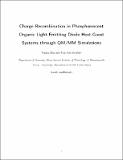Charge Recombination in Phosphorescent Organic Light-Emitting Diode Host–Guest Systems through QM/MM Simulations
Author(s)
Zhu, Tianyu; Van Voorhis, Troy
DownloadZhu16JPCC.pdf (8.740Mb)
PUBLISHER_POLICY
Publisher Policy
Article is made available in accordance with the publisher's policy and may be subject to US copyright law. Please refer to the publisher's site for terms of use.
Terms of use
Metadata
Show full item recordAbstract
Host–guest systems are crucial for achieving high efficiency in most organic light-emitting diode (OLED) devices. However, charge recombination in such systems is poorly understood due to complicated molecular environment, making the rational design of host–guest systems difficult. In this article, we present a computational study of a phosphorescent OLED with 2,8-bis(triphenylsilyl)dibenzofuran (BTDF) as the host and fac-tris(2-phenylpyridine) iridium (fac-Ir(ppy)₃) as the guest, using a combined quantum mechanics/molecular mechanics (QM/MM) scheme. A new reaction coordinate is introduced to measure the electrostatic interactions between the host and guest molecules. Ionization potentials and electron affinities of the host show broader distributions as the host–guest interaction increases. On the basis of these distributions, we describe a molecular picture of charge recombination on the guest and find a direct charge trapping route for this system. Our results suggest several strategies for the design of more efficient host and guest combinations.
Date issued
2016-09Department
Massachusetts Institute of Technology. Department of ChemistryJournal
Journal of Physical Chemistry C
Publisher
American Chemical Society (ACS)
Citation
Zhu, Tianyu, and Troy Van Voorhis. “Charge Recombination in Phosphorescent Organic Light-Emitting Diode Host–Guest Systems through QM/MM Simulations.” The Journal of Physical Chemistry C 120, 36 (September 2016): 19987–19994 © 2016 American Chemical Society
Version: Author's final manuscript
ISSN
1932-7447
1932-7455